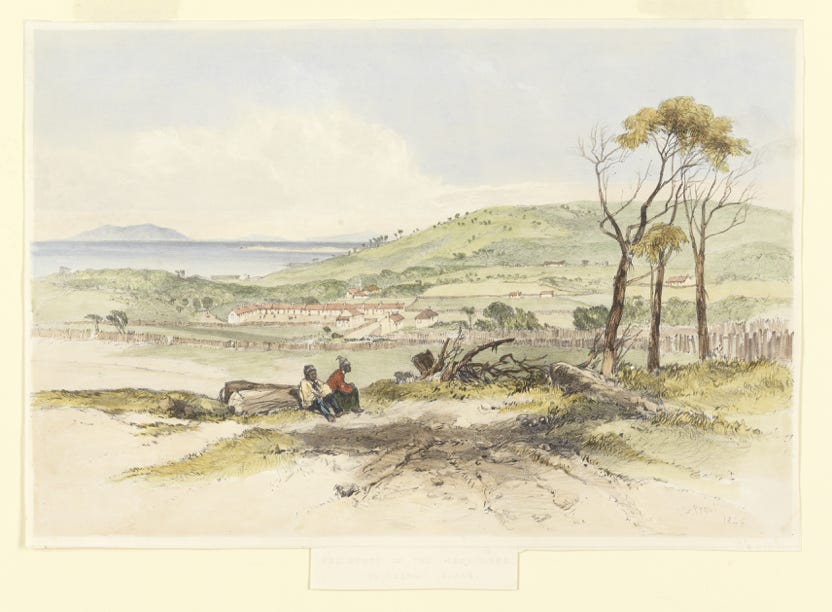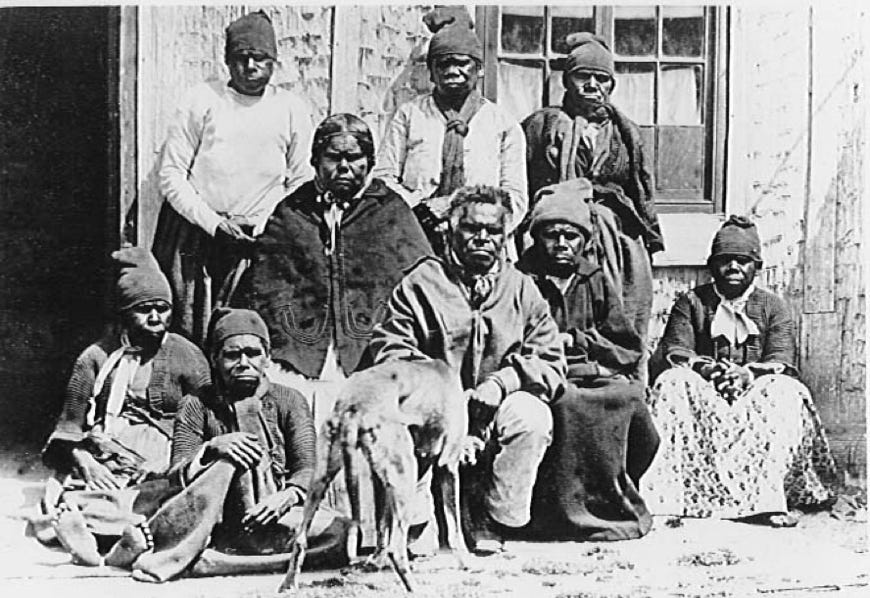Part B.
1830 - Following the Tasmania Wars the surviving traditional owners were rounded up

Mount Wellington and Hobart Town from Kangaroo Point by John Glover
[Public domain], via Wikimedia Commons

Residence of the Aborigines Flinders Island by J.S. Prout.
Digitised item from: Allport Library and Museum of Fine Arts, Tasmanian Archive and Heritage Office

Aborigines at Oyster Cove, Tasmania, 1858 by Francis Nixon
Collection: National Portrait Gallery, Canberra
Image via Wikimedia Commons
Van Diemen’s Land 1830
…”A rapidly growing British population in Tasmania and the ongoing destruction of Aboriginal tribes by disease, dispossession and violence led to intense conflict between the two groups. Tasmanian Aborigines were vehemently opposed to British expansion and its impact on their home and communities.
…On 7 October 1830, more than 2200 settlers, military, police and convicts, reported to seven prearranged locations across the settled districts. The largest force ever mobilised against Aboriginal people anywhere in Australia, the line represented about ten per cent of the European Tasmanian population. …The small population of about 200 Tasmanian Aborigines who remained in the settled districts after the line were gradually removed to Wybalenna, a settlement on Flinders Island in Bass Strait run by Robinson. Confined to poor accommodation, exiled from their homes, suffering emotional trauma, plagued by disease and severely malnourished, most of those at the settlement died within a few years.” http://www.nma.gov.au/online_features/defining_moments/featured/the-black-line
…”Tasmania is constructed from the precepts of the Black War, a period of cross cultural conflict initiated by British official occupation from 1803 that intensified by the 1820s, resulting in the Government managed Black Line campaign of 7 Oct – 24 Nov 1830 that culminated in a purported 3500 armed ‘settlers’ and military, supported by £30,000 of Government expenditure, attempting to militarily force, over a period of six weeks, Aboriginal people remaining at large in the ‘settled districts’ onto the Tasman Peninsula. Although this campaign logistically failed, it is believed that it led to the surrender of the remaining openly adversarial Aboriginal people and resulted in their subsequent exile to Flinders Island, located off north eastern Tasmania.” Black War ~ Van Diemen’s Land CSO 7578
Shortly following the end of the Black Line campaign an address from the inhabitants of the district of Richmond was delivered to Governor Arthur. The deputation included George Armitage (son-in-law of Thomas Peters) and several of Thomas Peters’ neighbours. There were 167 signatures appended, including those of Thomas and Richard Peters.
1 February 1831
To His Excellency Colonel George Arthur Lieutenant Governor of Van Diemen’s Land
The respectful address of the Inhabitants of the Police District of Richmond, in public assembled –
May it please Your Excellency
We the Landed Proprietors and other inhabitants of the Police District of Richmond, having long observed the unwearied and devoted attention of Your Excellency to the faithful discharge of the duties of your high office, and your care for the welfare and security of every class of His Majesty’s subjects entrusted to your Government, and many of us having had recent opportunity of observing the great personal privations which Your Excellency endured, and the incessant exertion of which you set the example, in the late attempt to capture the hostile Aborigines.
We cannot let the present occasion pass without addressing Your Excellency, to express our esteem and our gratitude for your exertion on every occasion for the protection of our persons and Property, and the advancement of our prosperity.
While we regret that natural obstacles have hitherto defeated every attempt for the capture or subjugation of the Aborigines, our last experience of your measures gives us every assurance that Your Excellency will not relax your exertions in this cause until by the blessing of providence you have exceeded in the accomplishment of your humane intentions towards them, and in the meantime we are confident that Your Excellency will make every necessary provision for the protection of the people who are exposed to their attacks; And we beg leave to assure you that we will always be ready to render every assistance which Your Excellency may require from us, in carrying into effect whatever measures you may see proper to be adopted, for that purpose. … https://blackwarvandiemensland.wordpress.com/vol-316/

Image Left ~ Bock, Thomas 1790-1855: Manalargena, a chief of the eastern coast of Van Diemen's Land. [between 1830 & 1835] Reference Number: A-031-006 http://mp.natlib.govt.nz/detail/?id=27020
…“In the early 1830’s, authorities exiled 134 Tasmanian Aborigines to Wybalenna on Flinders island in Bass strait, about 50 kilometres north of the Tasman mainland. The people worked to keep their culture strong, but their sense of loss was profound.
Mannalargenna was the leader of the Cape Portland people from north-east Tasmania. He had negotiated with George Augustus Robinson, the Protector of Aborigines, for his people to remain in their country in return for assisting Robinson. In about 1834, Mannalargenna and his people were exiled to Flinders Island. Although Mannalargenna had kept his word, Robinson had not.”
http://www.nma.gov.au/encounters_education/community/flinders_island
In 1847, 47 Tasmanian Aboriginal people incarcerated for fifteen years at Wybalenna on Flinders Island arrived to take up forced residency at Oyster Cove station, an ex-convict government settlement 35 miles south of Hobart. The arrivals consisted of 5 boys, 5 girls, 23 women and 14 men, all who remained of some 200 Tasmanian Aboriginal people who had been compulsorily and officially removed from across Tasmania. Their return was officially recorded as a budgetary measure, but could also be viewed as a means to allay guilt for what non-Aboriginal people viewed as the 'last' of a distinct race dying outside their home territory to which they had continually asked to return.
There was outrage at the return to mainland Tasmania of its original inhabitants. Tasmanian pastoralists recalled bloody skirmishes, and held a special meeting to protest the advent of 'these savages to their primitive home'. In part responding to these fears, the government described the non-threatening state of the thirteen Aboriginal men, saying they had either been reared by Europeans or worked for them, had lived for fifteen years 'in civilised habits' and 'are almost all addicted to gardening'. On arrival, eight children were removed to the Queen's Orphan Asylum in Hobart, and it is not known what eventually became of four of them. http://www.utas.edu.au/library/companion_to_tasmanian_history/O/Oyster%20Cove.htm
Research - Part B
29. RESEARCH Part B - A story of Thomas and Ann Peters.
30. RESEARCH Part B - Thomas Peters is transported for the term of his natural life
31. RESEARCH Part B - Mary Ann Peters accompanied her convict husband
32. RESEARCH Part B - 1803 Thomas, Mary Ann, & Elizabeth (2yrs) came to Port Phillip aboard the Calcutta
33. RESEARCH Part B - 1804 Peters family transferred to Van Diemen’s Land & Martha is born
34. RESEARCH Part B - 1805 Hobart Town: Mary Peters receives a Land Grant on New Town Rivulet
35. RESEARCH Part B - 1806 & 1807 The Peters have a farm with 4 cattle 2 sheep & a goat.
36. RESEARCH Part B - 1808 - 1812 Hobart Town: Martha dies, Thomas is pardoned, & 3 babies are born.
37. RESEARCH Part B - 1814 Hobart Town: Property deals, Horse races & a baby.
38. RESEARCH Part B - 1815 - 1816 Hobart Town: A juror, a boat race, supplying wheat & meat + 8th child
39. RESEARCH Part B - 1817 Hobart Town & York Plains: Thomas Peters receives a Land Grant
40. RESEARCH Part B - 1817 Hobart Town & Bagdad: the Duke of York & Baker’s farm
41. RESEARCH Part B - 1817 Hobart Town,York Plains, Bagdad & Tarrets’s farm
42. RESEARCH Part B - 1817 Hobart Town & Bagdad: Education, an executor, & stock moved from Herdsman’s Cove.
43. RESEARCH Part B - 1818 Hobart: A heavy cart and a ferry accident
44. RESEARCH Part B - 1818 Hobart: A court case, a house for sale. & Elizabeth marries George Armytage
45. RESEARCH Part B - 1818 Hobart: Stock on Birch’s land + Kickerterpoller & the Friendly Missions
46. RESEARCH Part B - 1819 Hobart: Rents to Supreme court & Mary Ann Peters (nee Hews) dies aged 39
47. RESEARCH Part B - 1819 - 1821 Hobart: Found guilty of ‘contumacious conduct in court’.
48. RESEARCH Part B - 1824 - 1829 Bagdad: Louisa marries John Hayes & Charlotte marries Francis Flexmore
49. RESEARCH Part B - 1830 Tasmania: The Black Line.
50. RESEARCH Part B - Nov 1930 Many Aborigines slip through the Black Line and the Peters house is raided.
51. RESEARCH Part B - 1830 Bagdad: As the Black Line advances settlers houses are attacked
52. RESEARCH Part B - 1830 Bagdad: Sophia Peters (16) and Ann Peters (14) are speared & Ann dies of her wounds.
53. RESEARCH Part B - 1830 - Following the Tasmania Wars the surviving traditional owners are rounded up
54. RESEARCH Part B - 1831 - 1839 Bagdad: Mary Ann Peters & Sophia Matilda Peters both got married,
55. RESEARCH Part B - 1839 Bagdad Thomas Peters dies
56. RESEARCH Part B - The 8 Children and 48 Grandchildren of Thomas & Mary Ann Peters
57. RESEARCH Part B - A Story of Thomas Peters and ‘the Brady Gang’
58. RESEARCH Part B - Where to next? Choices, choices, choices.

